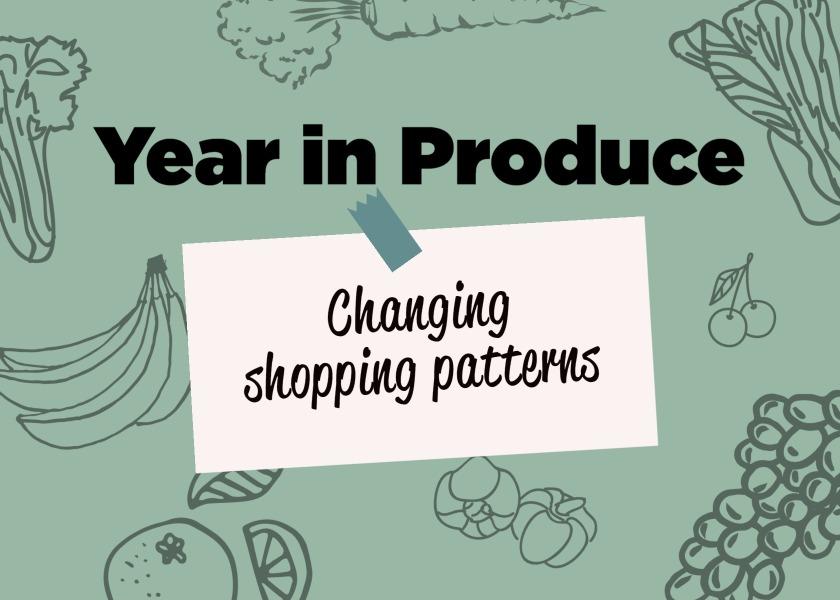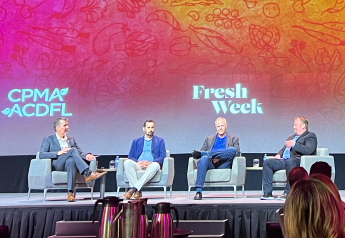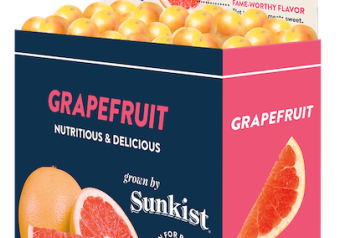Year in Produce No. 1 — Changing shopping patterns

Grocery shopping patterns shifted significantly during the first 10 months of the COVID-19 pandemic. Foot traffic, basket size and trip frequency were among the metrics that saw remarkable changes, along with many consumers purchasing their groceries online.
Nov. 24
Produce retail sales still well above 2019 baseline
By Ashley Nickle
Fresh produce sales at retail totaled $4.86 billion in October, up 7.5% from the same period in 2019, as consumers continue to stay in their homes more amid the pandemic.
Overall, produce retail sales are expected to remain strong through the holidays, though fewer people will be engaging in Thanksgiving gatherings this year, according to IRI. A recent consumer survey by the organization found that only 26% plan to host or attend a meal with family who don’t live with them, down from 48% last year.
“These predictions point to many potential changes for the produce department,” Anne-Marie Roerink, principal of 210 Analytics, wrote in the release.
“Some shoppers are predicting serving different meats or several smaller gatherings. This may result in different fruits and vegetable choices.
“Retailers should plan for an earlier spike in holiday item purchasing than last year,” Roerink wrote. “One in five people plan to shop more than three days earlier than last year, either to avoid crowds or out-of-stocks.”
Oct. 21
Retail produce sales strong; fresh share of produce dollar slips
By Ashley Nickle
Fresh produce sales at retail totaled $5.04 billion in the four September weeks, up 10.7% from the same period in 2019.
In 2019, fresh had 84% of the produce dollar share compared with 10% for shelf-stable and 6% for frozen. That share dipped to 70% in the first weeks of the pandemic but slowly climbed almost all the way back, to 83%, in July. For September, however, the fresh share of the produce dollar was 80.3%.
“It is important to point out that inflationary levels in frozen and canned goods have been higher than those in fresh produce, which impacts dollar shares,” Jonna Parker, fresh team lead for IRI, said in the release. “However, the pandemic has definitely fueled a consumer desire for items with longer shelf-life, whether that is hardier fresh fruits and vegetables or diverting dollars to canned and frozen.”
Sept. 2
Info on trips, spending show what’s driving retail sales growth
By Ashley Nickle
Consumers are buying fresh produce during more shopping trips and spending more per trip on fresh produce than they did in 2019.
For the 26 weeks ending Aug. 23, trips during which produce is purchased are up 5.9%, and produce spend per trip is up 7.6%, according to IRI. Spend per buyer is up 13.8%.
For fruit, trips are up 3.8%, spend per trip up 5.7%, and spend per buyer up 9.3%. For vegetables, trips are up 10%, spend per trip is up 7.3%, and spend per buyer is up 18.1%.
“Salad items have been doing extremely well throughout the pandemic, both convenience-focused bagged salad kits and the individual ingredients,”
Watson said in the release. “Salad is a big item in restaurant foodservice as well as in retail foodservice, and it appears consumers are replicating that salad occasion at home for lunch and dinner.”
May 13
Survey shows how shopper behaviors in stores are changing
By Ashley Nickle
A 2,000-person survey by Category Partners reveals some of the ways consumers are changing what they’re buying and how they’re navigating stores amid the COVID-19 pandemic.
Just over 50% of respondents said they are purchasing more frozen foods and center-store items due to coronavirus, while roughly 40% said they are buying more fresh fruit, fresh vegetables, fresh meat and dairy. On the flip side, roughly 20% said they were buying less fresh fruit, fresh vegetables and fresh meat.
“This increase in food purchases among younger consumers makes sense,” Cara Ammon, senior vice president of research and market intel for Category Partners, said in a news release. “Many are now working from home, or unfortunately are at home due to furlough, and many may have children home from school. Families have gone from eating lunches and even breakfasts at work and school and eating many dinners on the run to eating all of their meals at home. That makes a huge difference in their grocery purchases.”
The firm’s survey also indicated a shift toward packaged items, with 46% of respondents saying they are buying more packaged items and 25% of respondents saying they are avoiding loose items. More than 40% report avoiding self-service items like products from salad bars or soup bars, and 35% say they are avoiding products requiring store staff to handle the food. Thirty-six percent of respondents noted they are using self-checkout more often.







